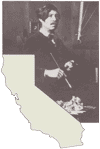![]()

Five Views: An Ethnic Historic Site Survey for California
MENU
Introduction
Mexican War
Post-Conquest
1900-1940
World War II
Chicano Movement
Future
Historic Sites
Selected References

A History of Mexican Americans in California:
HISTORIC SITES
Plaza De la Raza / Lincoln Park
Los Angeles, Los Angeles County
Plaza de la Raza is a complex of one-story stucco buildings organized around an open patio, adjoining the old Lincoln Park Boathouse. The units of this complex are designed with a modernistic architectural theme. Several of the buildings have low-pitched roofs with gable ends hidden by parapet walls. The old boathouse is built of brick. It is a utilitarian structure with low, arched walls and a tower with a pyramidal, red-tile roof. The boathouse is in virtually unaltered condition.
Lincoln Park, where Plaza de la Raza is located, has long been the recreational center of East Los Angeles. Owned originally by Dr. J. S. Griffin, the land was purchased by the city in 1874 and was subsequently transferred to the Southern Pacific Railroad Company in return for establishment of railroad shops in East Los Angeles. The land reverted to the city when Southern Pacific failed to build the promised shops. The city then laid out a park, initially called East Los Angeles Park and then Eastlake Park, which quickly became a major amusement center for the people of Los Angeles. One of its main attractions was the area's first zoological display. In 1917, the site became known as Lincoln Park.
The Mexican American population of East Los Angeles, today more than 150,000 in number, has relied extensively on Lincoln Park as a recreation site. In 1970, moreover, Plaza de la Raza was incorporated, and officials secured a lease from the City of Los Angeles to operate the plaza in Lincoln Park for 25 years.
The incorporation of Plaza de la Raza was a pivotal point in the cultural history of the Chicano community in Los Angeles. Based on the concept of the town plaza around which the economic, social, political, and cultural life of people in Hispanic communities revolved, Plaza de la Raza was conceived as a cultural-educational center, to serve the Chicano/Latino community in Los Angeles by promoting Hispanic forms of artistic and cultural expression. Also significant to development of the plaza were the leadership and involvement of Chicano/ Latino actors and actresses, business people, and others associated with film, communications, and miscellaneous other industries in Southern California. This is one of the identifiably ethnic endeavors the established Chicano/Latino middle and upper middle classes enthusiastically support and in which they have become intimately involved. In providing financial support and donating their talents and their time, members of the Chicano/Latino middle class are affirming and re-affirming their Chicano or Latino identity, which many had to deny or reject in order to achieve success in the racially discriminatory film and communications industries. Some of the people who have been central to the development and success of the plaza are members of NOSOTROS, the Chicano/Latino film actors organization.
With this community's expertise and assistance, as well as with funding from the Model Cities Program, the Los Angeles City Council, labor unions from Tijuana, the National Endowment for the Arts, and the Del Amo Foundation, Plaza de la Raza has implemented a myriad of vital cultural programs for the Chicano/Latino community and for the general public in Los Angeles. Focusing on the socio-cultural rather than the economic aspects of the traditional community, Plaza de la Raza was planned and constructed as an instructional, performing, and exhibition center.
Immediately after the first stages of remodeling and new construction were completed in 1973, the began classes in art, music, dance, creative writing, and drama for young and old alike. Also in 1973, in cooperation with the Los Angeles Unified School District, the plaza devised a cultural enrichment program to explore, examine, and teach Chicano/Latino history and culture through art forms. More than 300 school children attend these presentations each week. Drama, music, dance, art, and other forms of creative expression are also vital to the Head Start Program administered by plaza staff; the program has involved 21 classes for a combined total of 315 students in 10 different sites.
In addition to the creative and expressive arts program, the plaza offers instruction in communications and media including writers' workshops conducted by two television writers and a special class in comedy writing. Acting scholarships to the Lee Strasberg School of Drama are made available. The effort is to assist Chicanos and Latinos to develop skills and talents for employment and careers in the film and communications industry.
In its nine years of existence, Plaza de la Raza has indeed become the major Chicano/Latino cultural center in Los Angeles. Chicano/Latino musical groups and drama and dance companies perform to capacity audiences in weekly programs that also include fund-raisers for the plaza and other worthy causes. Receiving official endorsement from the City of Los Angeles as a Bicentennial Project, the plaza's efforts are directed toward ensuring perpetuation of the Chicano/Latino culture and bringing cross-cultural understanding to the larger community in Los Angeles.
Plaza de la Raza is a vital, exciting, creative force in the community. It is central to the cultural growth and development of the Chicano/Latino community, as well as the growth and development of the general public in Los Angeles.
NEXT> Ramirez Castle/Ellis House
Last Modified: Wed, Nov 17 2004 10:00:00 pm PDT
5views/5views5h71.htm
 Top
Top